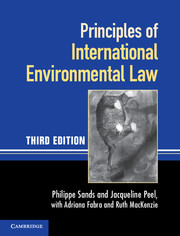Book contents
- Frontmatter
- Contents
- Foreword
- Preface and acknowledgments to the first edition
- Preface and acknowledgments to the second edition
- Preface and acknowledgments to the third edition
- Table of cases
- Table of treaties and other international instruments
- Abbreviations
- Part I The legal and institutional framework
- Part II Principles and rules establishing standards
- 6 General principles and rules
- 7 Atmospheric protection and climate change
- 8 Freshwater resources
- 9 Oceans, seas and marine living resources
- 10 Biological diversity
- 11 Hazardous substances and activities
- 12 Waste
- 13 The polar regions: Antarctica and the Arctic
- Part III Techniques for implementing international principles and rules
- Part IV Linkage of international environmental law and other areas of international law
- Index
- References
12 - Waste
from Part II - Principles and rules establishing standards
Published online by Cambridge University Press: 05 June 2012
- Frontmatter
- Contents
- Foreword
- Preface and acknowledgments to the first edition
- Preface and acknowledgments to the second edition
- Preface and acknowledgments to the third edition
- Table of cases
- Table of treaties and other international instruments
- Abbreviations
- Part I The legal and institutional framework
- Part II Principles and rules establishing standards
- 6 General principles and rules
- 7 Atmospheric protection and climate change
- 8 Freshwater resources
- 9 Oceans, seas and marine living resources
- 10 Biological diversity
- 11 Hazardous substances and activities
- 12 Waste
- 13 The polar regions: Antarctica and the Arctic
- Part III Techniques for implementing international principles and rules
- Part IV Linkage of international environmental law and other areas of international law
- Index
- References
Summary
INTRODUCTION
This chapter describes the rules of international law relating to the management of waste, including: prevention and treatment; disposal; recycling and re-use; and international movement (including trade). Liability for environmental damage caused by wastes is addressed in Chapter 17, and there is an emerging case law at the European Court of Human Rights linking waste with the protection of fundamental human rights. Except for rules on international trade in wastes, this remains a developing area of international law. Other than the particular rules applicable in the Antarctic and the EU, there is no regional or global legal framework for a waste management strategy. Rather, waste has traditionally been regulated incidentally to the attainment of other objectives. Among the relevant international legal measures are those regulating the disposal of wastes at sea; limiting atmospheric emissions of gaseous wastes; and preventing the disposal of wastes in rivers and other freshwaters. This approach does not address the source of the problem by preventing waste generation; it merely shifts the disposal problem to another environmental medium.
In the context of the massive increase in the generation of all types of waste resulting from industrial activity, this is a major shortcoming in the rules of international environmental law. Part of the problem is institutional: at the global level, no UN or other body has overall responsibility for waste, and this has led to a fragmented, ad hoc and piecemeal international response. The Stockholm Conference did not focus on the issue of waste as such: without specifically mentioning waste, Principle 6 of the 1972 Stockholm Declaration called for the discharge of toxic or other substances to be halted. The 1982 World Charter for Nature called for ‘special precautions’ to be taken to prevent discharge of radioactive or toxic wastes, but did not encourage minimisation of the generation of such wastes. At UNCED, the issue of waste was addressed in some detail and in a more concerted fashion in Agenda 21 with the development of proposals, including targets and timetables, for the management of hazardous wastes, solid wastes (including sewage) and radioactive wastes. Nonetheless, Principle 14 of the Rio Declaration limited itself to calling for effective co-operation to ‘discourage or prevent the relocation or transfer to other states of any activities and substances that cause severe environmental degradation or are found to be harmful to human health’.
- Type
- Chapter
- Information
- Principles of International Environmental Law , pp. 554 - 576Publisher: Cambridge University PressPrint publication year: 2012



